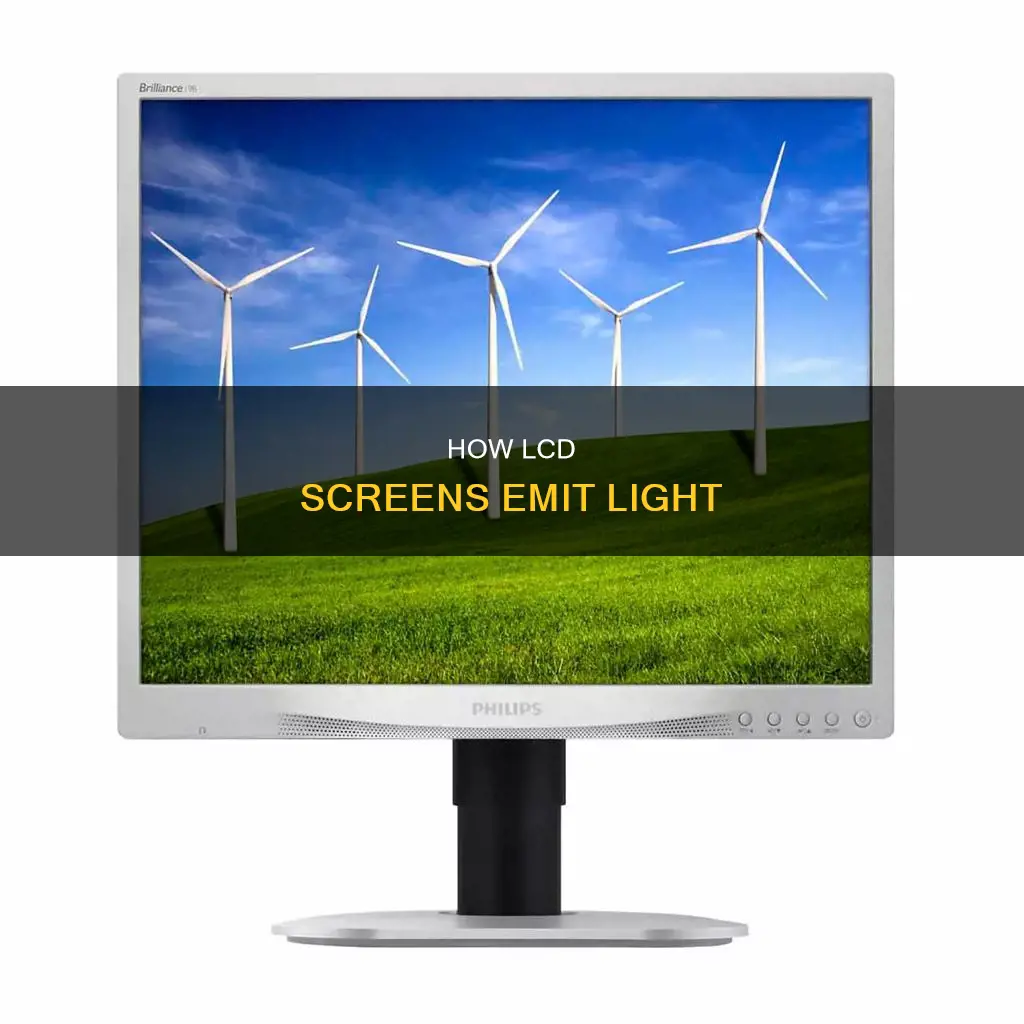
LCD monitors require an external light source to produce a visible image. This is because LCDs do not produce light by themselves. The illumination for LCD monitors is provided by backlights, which are often used in smartphones, computer monitors, and LCD televisions. The two types of backlight technologies used in LCD monitors are CCFL (cold cathode fluorescent lamps) and LED (light-emitting diodes). CCFL backlights were the preferred choice for LCD monitors until around 2010, after which LED backlighting became more popular due to its lower power consumption, thinner panel design, and high-speed switching capabilities.
| Characteristics | Values |
|---|---|
| What is an LCD Monitor? | Liquid Crystal Display (LCD) monitors feature a layer of liquid held between two pieces of polarized glass. The LCD monitor does not produce its own light. |
| How does an LCD Monitor work? | The electric current aligns the crystals in the liquid layer, which allows or blocks light, depending on what color it's supposed to display. |
| What provides illumination for an LCD Monitor? | Backlights. |
| What are the two types of backlight technologies used in LCD Monitors? | CCFL (Cold Cathode Fluorescent Lamps) and LED (Light-Emitting Diodes). |
| What are the pros of an LED LCD Monitor? | Thin and lightweight, short/fast response time, consistent brightness, and backlight dimming options for optimal contrast/color quality. |
| What are the cons of an LED LCD Monitor? | Some edge-lit LED monitors can be hard to see at certain viewing angles, and they are expensive. |
What You'll Learn

Light sources for backlights
Light-Emitting Diodes (LEDs)
LEDs are commonly used as a light source for backlighting in LCD monitors. They are known for their small size, resembling miniature Christmas lights. LEDs offer several benefits, including longer lifespans compared to CCFL bulbs, more even illumination, and reduced power consumption. Modern LCD monitors often feature full-array LED backlighting or edge lighting. Full-array LED lighting evenly distributes diodes across the monitor for uniform brightness, while edge lighting places LEDs around the perimeter, spreading light with a plastic sheet. Mini-LED technology further enhances lighting control by allowing for even finer adjustments.
Cold Cathode Fluorescent Lamps (CCFLs)
CCFLs were once the standard backlight technology in older LCD monitors. They are fluorescent lamps that operate with either hot or cold cathodes. CCFLs are less energy-efficient than LEDs and may not provide as uniform a level of illumination, especially in darker environments. However, they were widely adopted due to their cost-effectiveness.
Electroluminescent Panels (ELPs)
ELPs are another option for backlighting in LCDs. They produce uniform light across their entire surface, making them suitable for larger displays or applications where even lighting is crucial. ELPs require high-voltage AC power, typically supplied by an inverter circuit.
Hot Cathode Fluorescent Lamps (HCFLs)
HCFLs are a type of fluorescent lamp that operates with a hot cathode. They are used in a variety of applications, including backlighting for LCDs. HCFLs come in diameters ranging from 6.0mm to 20mm.
External Electrode Fluorescent Lamps (EEFLs)
EEFLs are fluorescent lamps that use external electrodes. They are one of the various light sources that can be employed for backlighting in LCD displays.
Incandescent Lightbulbs
Incandescent lightbulbs were used in early LCD panels to achieve high brightness. However, their limited lifespan and excessive heat generation posed significant challenges. The heat produced by these bulbs often required mounting them away from the display to prevent damage.
Sportage's LCD Monitor: A Clear View Ahead
You may want to see also

CCFL backlights
CCFL, or cold cathode fluorescent lamp, backlights are a form of illumination used in LCDs. LCDs do not produce light themselves, so they require either ambient light or a special light source to produce a visible image. CCFL backlights are placed behind the LCD, providing illumination from the back or side of the display panel.
However, CCFL backlights also have some disadvantages. They contain mercury, which has led to many countries limiting or banning them. CCFL backlights also have a shorter lifetime, require higher voltage, and are more difficult to repair and maintain.
Disabling Your HP LCD Monitor: A Step-by-Step Guide
You may want to see also

LED backlights
- A wider colour gamut and dimming range
- Greater contrast ratio
- Slim and lightweight design
- Lower power consumption and longer lifespan
- Mercury-free manufacturing
LED-backlit LCDs can be categorised into two types: edge-lit (ELED) and direct-lit (DLED) or full-array. Edge-lit LED backlights form a line around the rim of the screen, while direct-lit LEDs are arranged in an array directly behind the screen. Both types may support frame dimming and local dimming, which adjust the brightness of the backlight based on the content displayed.
The use of LEDs for backlighting in LCDs has become increasingly common due to its many benefits. However, it is important to note that LED-backlit LCDs cannot achieve true blacks for pixels, as some light from the backlight still comes through even when pixels are turned off. Additionally, local dimming can result in a "blooming" or "halo" effect on dark pixels.
Overall, LED backlights offer improved display quality, energy efficiency, and thinner designs compared to traditional CCFL backlights.
Asus Monitors: DVI Cable Inclusion or Exclusion?
You may want to see also

ELP backlighting
An electroluminescence panel (ELP) is a technology that uses coloured phosphors, not heat, to generate light. It is also known as electroluminescent (EL) backlighting. ELP backlighting is often used for larger displays or when even backlighting is important. It can be either coloured or white.
However, ELP backlights cannot be manufactured in larger sizes. They require an AC signal, which generates noise that can interfere with neighbouring circuits. The AC signal must be generated from a standard DC signal with an inverter. The half-life of ELP backlights is much shorter than other backlighting technologies, at 3k to 5k hours.
While ELP backlighting was once a common form of backlighting, it is now becoming less popular. LED backlighting is now the standard.
Monitoring FPS, CPU, GPU, and RAM: A Comprehensive Guide
You may want to see also

Incandescent backlighting
Incandescent light bulbs are only used for backlighting when cost is a major factor. While they are very bright, they are not uniform, generate a significant amount of heat, have short lifespans, and use a lot of power for the brightness achieved. They can provide very white light, but the colour can change with changing supply voltages, and they can be sensitive to shock and vibration.
LED backlighting is now the most common type of backlighting for LCD displays due to its many advantages over other types, including longer lifespans, lower power consumption, and thinner designs.
Where to Find Your ASUS Monitor Model Number
You may want to see also
Frequently asked questions
Backlights provide the illumination for LCD monitors.
Backlights are a form of illumination that provides light from the back or side of a display panel. LCDs do not produce light themselves, so they need illumination to produce a visible image.
Examples of backlights include light-emitting diodes (LEDs), cold cathode fluorescent lamps (CCFLs), and electroluminescent panels (ELPs).







